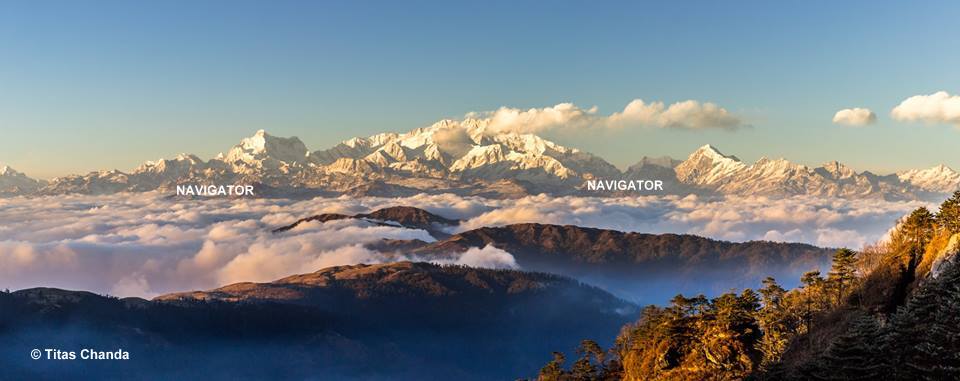Darjeeling is a district in the Indian state West Bengal. It is located in the Singalila Range of Eastern Himalaya. Darjeeling is famous for beautiful tea gardens and the Darjeeling Himalayan Railway (DHR) the ‘Toy Train’, a UNESCO World Heritage Site. World third highest peak Mt.Kanchendzonga (8,587mtr.) is visible from various places in this hilly district.
Places to visit in Darjeeling Himalaya:
Darjeeling – a popular hill station, famous for tea & it’s beautiful landscape. Read more.….
Kalimpong – another important hill station in Bengal just 70km away from Siliguri. It is famous for it’s nurseries with various colourful flowers & orchids. Read more….
Kurseong –on the way from airport to just 31km away from Darjeeling. It is the educational hub of this region & also known for beautiful tea gardens. Read more….
Mirik –just 49km from Siliguri Mirik is famous of its Sumendu Lake. The route to Mirik offers magnificent view of teagardens & alpine forests. Read more….
Lava & Loleygaon –Lava is just 32 from away from Kalimpong & Loleygaon is another 23km drive. Both are surrounded by alpine forests & natural resources all around. It’s a paradise bird watchers. Read more….
Best Time to Visit
Best time to visit Darjeeling:
You can plan your travel to this region at any time of the year. Every season will offer you a different flavor. it mainly has five seasons.
Spring (March to April): it is considered a very good season with moderate temperature. This is the time for rhododendrons, orchids & various flowers. Snow will also be visible in some parts of the district.
Summer (May to Jun): as summer is not very hot. It draws the maximum no of tourist. Most of the regions of the region experience a temperature clime & it ranges from 180C (600F) to 280C (820F).
Monsoon (Jul to Mid Sep): this is the time when the region gets maximum rainfall. Darjeeling is an ideal place to enjoy Indian monsoon with lush green tea gardens, hills along with beautiful clouds & fog. But heavy rain increases the risk of landslide during monsoon.
Autumn (Mid Sep to Nov): Just after monsoon this is probably the best time to visit the region with clear sky & moderate temperature. It is also a good time for photography.
Winter (Dec to Feb): These are the coolest months & some part of this himalayan district receives a snowfall. One can have snow in Sandakphu (32km from Darjeeling). Singalila range is a place with some of the highest snow capped peaks of the world.
Temperature Chart :
| Month | o Celsius | Darjeeling | Kalimpong | Kurseong |
| January
| Max Min | 9.9 3.3 | 16.1 8 | 13.6 6.7 |
| February
| Max Min | 11.6 4.6 | 17.3 9.4 | 15 8 |
| March
| Max Min | 15.5 7.9 | 21.3 12.6 | 19.3 11.4 |
| April
| Max Min | 18.6 10.9 | 23.8 15.4 | 22. 14.1 |
| May
| Max Min | 19.2 13 | 24.7 17.5 | 22.4 15.9 |
| June
| Max Min | 19.7 14.9 | 25 19.2 | 22.6 17.5 |
| July
| Max Min | 20.2 15.5 | 24.7 19.4 | 22.8 18 |
| August
| Max Min | 20.2 15.5 | 24.8 19.5 | 23. 18 |
| September
| Max Min | 20.2 14.8 | 24.7 19.1 | 22.8 17.4 |
| October
| Max Min | 19 11.6 | 24 16.4 | 21.8 14.8 |
| November
| Max Min | 15.6 7.5 | 20.7 11.9 | 18.6 10.8 |
| December
| Max Min | 12.3 4.6 | 17.9 9 | 15.5 7.9 |
To Reach
How to reach Darjeeling :
By Air:
The nearest operational airport in Bagdogra (IXB). Bagdogra to Darjeeling is 78km, Kalimpong 80km & Kurseong is approx 45km & Mirik 49km. Bagdogra is directly connected with Delhi, Kolkata, Guwahati & Bangkok & it is indirect connection all major cities in India.
By Rail:
The nearest railway station is New Jalpauguri (NJP) located near Siliguri. NJP is well connected with all major cities in India. NJP to Darjeeling is 78km, Kalimpong 75km & kurseong is 45km.
By Road :
Darjeelingdistrict is connected with Siliguri/Bagdogra/NJP through national National Highway 55 & 31A. North Bengal State transport Corporation (NBSTC) operates regular buses from Siliguri to various destinations like Darjeeling, Kalimpong, Mirik, Lava ect. Private buses are also available from Tenzing Norgay Bus Terminus.
History
History of Darjeeling
The British India, Nepal, Sikkim & Bhutan have their extensive presence in the rich history of Darjeeling. The kingdom of Sikkim ruled the hilly belt of Darjeeling until the early 19th century. During that period, the Nepalese Kingdom frequently occupied the plains around Siliguri. This settlement took place comprising of few villages of Lepcha and Kirati people. The Gurkhas of Nepal came victorious over The Chogyal of Sikkim on their repeated attempt to get the hold of the Himalayan Heaven. From 1780, the Gorkhas made several attempts to capture the entire region of Darjeeling. The Gurkhas had overrun Sikkim as far eastward as the Teesta River and had thwarted and attached the Terai, in the beginning of 19th century. On arrival of the British, the Gurkhas were been averted from capturing the whole of the northern frontier. The Gurkhas were been defeated in the Anglo-Gurkha war in 1814 that led to the signing of the Sugauli Treaty in 1815.As per the treaty, Nepal had to relinquish the territories which the Gurkhas had attached from the Chogyal of Sikkim to the British East India Company. The area was in between the Mechi River and the Teesta River. The British East India Company brought the Treaty of Titalia in 1817, through which it secured all the tracts of land of that region & restored the Chogyal of Sikkim and guaranteed his preeminence.
Initially The Darjeeling area was a “Non-Regulation District”. It was a scheme of British administration applicable to regions, economically underdeveloped. This status was not automatically applied to the other districts of rest of the country. The Darjeeling area was declared a “backward tract” in 1919. The Non-cooperation Movement proliferated through the tea belt of Darjeeling during the during the struggling days of the Indian independence movement. Darjeeling was merged with the state of West Bengal post-Independence. Darjeeling was established as a separate district consisting of three hill towns of Darjeeling, Kalimpong & Kurseong along with some parts of the Terai region. In the initial days, the ethnic Nepalese populated the hill part of the district & the Bengali refugees’ majorly domiciled the plain, post-partition of India. There was several public unrest since the initial days in the hills of Darjeeling to have the autonomous status of the ethnic Nepalese, which escalated to an alarming level in the sixth decade due to the unreceptive response by the state government. However one of their major demands tasted its success was the recognition of the Nepali language in 1961.
Map
Darjeeling Tourist MAP
Booking
Fill the form below to send your enquiry. Comments or questions are welcome.

